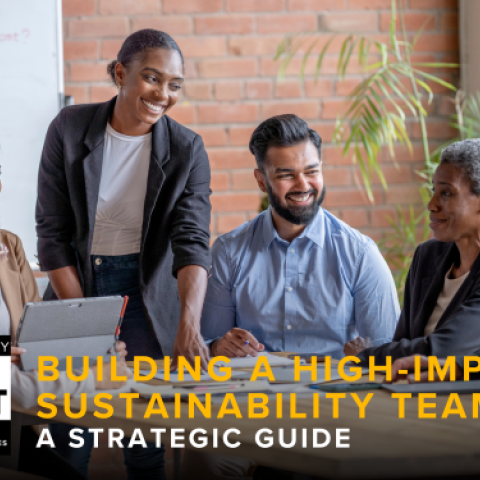Building a High-Impact Sustainability Team: A Strategic Guide

Exclusively sponsored by Honeycomb Strategies.
As more organizations recognize the environmental impact of their operations, many are beginning to take a closer look within, seeking ways to improve their practices. One great approach is to create an internal task force, which fosters employee engagement and drives meaningful progress in sustainability efforts. An effective sustainability team, or “Green Team,” can lead the way in coming up with creative sustainability solutions that benefit your organization.
To get started and work effectively, here’s a framework for building and managing an effective sustainability team.
Understanding the Role of a Sustainability Team
A sustainability team is not just about reducing a company’s environmental footprint; it’s about integrating sustainability into the core of the business strategy. Potential benefits of the team include driving initiatives that meet regulatory requirements and creating value by enhancing the company’s reputation, encouraging innovation, and improving financial performance. The team’s work spans across various domains, including environmental stewardship, social responsibility, and governance (ESG) practices, so it’s important to remember to include representative members from across your business.
Key Steps in Building a Sustainability Team
1. Executive Support and Leadership: Securing executive support is crucial for the success of the sustainability team. Leadership buy-in ensures that sustainability is prioritized at the highest levels, providing the team with the necessary resources and authority to implement initiatives.
2. Cross-Functional Collaboration: Sustainability is an interdisciplinary field that requires collaboration across various departments, including operations, finance, marketing, and human resources. Establishing a diverse team ensures that sustainability initiatives are integrated into all aspects of the business. This collaboration also promotes innovation by bringing varied perspectives to the table.
3. Create your Structure: Decide on a working model for your task force that determines your team leadership, how often membership is swapped out, and where the team is positioned in the organization’s overall structure. These will help you understand what your scope and reach is and develop the mechanism for working together.
4. Talk About Talking: Communication is an essential component to sustainability and can contribute to an outcome of increased efficiency in the workplace. Be proactive in determining the channels of communication, frequency of meetings and of updates between team members, and laying out protocols for reporting and team challenges that may arise.
5. Establish Clear Objectives: The first task for your sustainability team is to define your organization’s sustainability goals. These objectives should align with the overall business strategy and reflect the company’s commitment to sustainable practices. Whether the focus is on reducing carbon emissions, improving supply chain transparency, or enhancing community engagement, clear goals provide direction and purpose to the team.
6. Measure and Communicate Impact: Effective sustainability teams measure their impact through qualitative observation and metrical key performance indicators, where relevant. Regular reporting on progress demonstrates the value of sustainability initiatives to backers or skeptics and helps refine strategies.
Challenges and Opportunities
Building a sustainability team comes with its challenges, including securing funding, discerning competing priorities, navigating regulatory complexities, and overcoming resistance to change. However, these challenges also present opportunities for growth and innovation. By staying agile and adapting to the evolving sustainability landscape, companies can turn these challenges into opportunities to lead in their industries.
Don’t forget to make it fun!
Despite the challenges, this work can be very rewarding. Sustainability is about creating systems for environmental and human worlds to thrive, so let in the light! The team’s work doesn’t have to be task lists and drudgery, but can involve community building, cultural sharing, and new experiences that enrich both members and the work outcomes. By approaching a sustainability team with a mindset of balance, respect, and joy, chances are you’ll increase involvement and productivity. One of the best parts of sustainability in the event industry is the opportunity to influence change and create awareness – make it fun!
Let’s get to it!
Building a sustainability team can be a strategic game-changer for organizations aiming to distinguish themselves in a competitive field and stay relevant and accountable. A high-impact sustainability team drives long-term value, enhances corporate reputation, and contributes to a sustainable future. With the right leadership, resources, and commitment, a sustainability team can be a powerful force for positive change.
Honeycomb Strategies specializes in impactful solutions for sustainable events, sports, and venues. hcsustainability.com /hello@hcsustainability.com


Add new comment